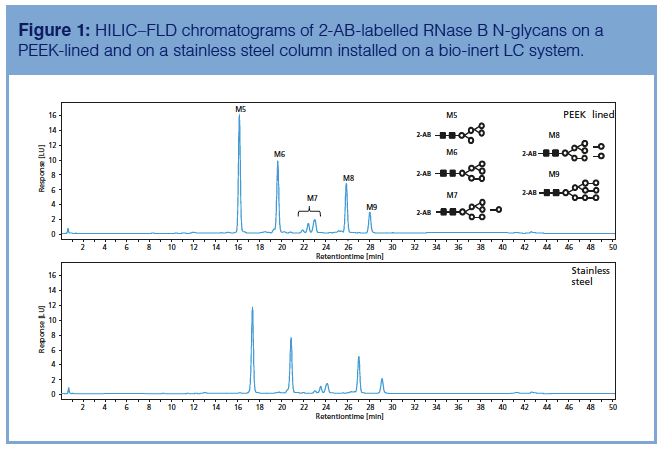Pixelating Petroleomics
LCGC Europe
LCGC Europe spoke to Guilherme L. Alexandrino from the University of Copenhagen, Denmark, about the benefits of combining a modern “pixel-based” chemometrics technique with comprehensive two‑dimensional gas chromatography (GC×GC) in petroleomics applications.
LCGC Europe spoke to Guilherme L. Alexandrino from the University of Copenhagen, Denmark, about the benefits of combining a modern “pixel-based” chemometrics technique with comprehensive twoâdimensional gas chromatography (GC×GC) in petroleomics applications.
Q. Do you think analysts are unnecessarily “scared” about using GC×GC?
A: Yes. The initial impression of GC×GC is that method development and data handling are both very complex. However, an understanding of the fundamental concepts of GC×GC, and particularly how the modulator works, makes method development simpler than it may first seem, and the number of publications on GC×GC has greatly increased in recent years. The data handling for two-dimensional chromatograms is also getting easier because the software from vendors and alternative open-source programs has become more “user-friendly”.
Q. Why is GC×GC useful in petroleomics?A: One dimensional (1D) gas chromatography–mass spectrometry (GC–MS) is generally well-established and commonly used for targeted analysis. However, there are some applications where GC×GC can overcome the analytical limitations of 1D GC. For example, in petroleum analysis 1D GC–MS still requires SARA (saturates, aromatics, resign, and asphaltenes) fractionation of the crude oils before the analysis to separate saturates and aromatic compounds. Without this step chromatographic interferences can still occur, even when using more selective techniques, such as GC–MS with selected ion monitoring (SIM).
This fractionation step can be laborious because it requires the use of organic solvents and is prone to cross-contamination. However, this limitation can be overcome by using GC×GC–MS with SIM (1) because the fractionation step for crude oils can be eliminated or, at least, simplified to remove all the asphaltenes because they cannot be analyzed by GC or GC×GC. In my view, GC×GC could also be used more routinely in other applications where the possibility of simplifying the sample preparation steps would be beneficial, for example, when associating GC×GC with “green” micro-extractions in metabolomics (2).
Q. What other benefits does GC×GC offer in petroleomics?
A: In analytical chemistry, the “omics” are generally based on the analysis of a wide range of chemical features in samples to discover specific compounds that have correlation with an external property. For petroleomics, it is useful to be able to identify a specific geochemical property. Petroleum is an extraordinary complex substance that contains hundreds of thousands of different organic and inorganic compounds.
The discovery of new petroleum biomarkers that can enhance the understanding of the physicochemical and geochemical properties of crude oils is seriously affected by coelutions when using 1D GC–MS. Chromatographic coelutions can often be handled quite satisfactorily when using selective MS techniques, such as SIM and tandem mass spectrometry (MS/MS), but for the discovery of new petroleum biomarkers it is very difficult when a selective analysis is required because everything else in the crude oils becomes “invisible” in the analysis.
The enhanced peak resolution and peak detection obtained by GC×GC with SIM has successfully handled this limitation, and a deeper understanding of the complex composition of the crude oils is achieved. For example, GC×GC has allowed the identification of new groups of petroleum biomarkers for improved geochemical diagnostics of crude oils (3,4,5) and has also increased the chromatographic resolution of the so-called unresolved complex mixture (UCM) in crude oils. The UCM comprises numerous branched-, cyclic-alkanes, and aromatic hydrocarbons that cannot be resolved by conventional GC, resulting in a hump in the chromatograms that can be clearly observed, especially for degraded oils (6).
Q. You recently developed a novel GC×GCÐMS method with SIM to investigate the inter-reservoir geochemical features of crude oil. What was the aim of this research?
A: This method aimed to combine the chromatographic advantages of GC×GC with selective detection to identify the most important groups of petroleum biomarkers in the nonpolar fraction of crude oils incorporating a novel data analysis strategy based on chemometrics (1).
We applied our new approach to the inter-reservoir discrimination of crude oils. The geochemical characterization of a petroleum reservoir is very important to understand its origin and its potential for economic exploitation. Although the “golden” method for geochemical investigation of petroleum is based on the peak integration of individual biomarkers obtained by GC–MS or GC–MS/MS, this method can be very laborious when trying to extract all the information potentially obtained by GC×GC. Additionally, the discovery of new patterns in the biomarkers “fingerprint” that distinguish crude oils from specific locations is more difficult and more “analyst-dependent”.
We aimed to overcome these limitations by using chemometrics to mathematically extract the main chromatographic patterns from wellâknown classes of biomarkers that distinguish crude oils from specific reservoirs from the entire 2D-SIM chromatograms.
We use all the chemical information potentially extracted by GC×GC because we directly handle the chromatographic signals (pixels) instead of user-extracted peak tables. This approach is called pixelâbased analysis, and when combined with chemometrics it successfully provides wider biomarker signatures that describe important geochemical features in crude oils.
In this case the chemical differences of crude oils originating from marine or lacustrine paleoâenvironments, and the discovery of biomarker patterns that described the inter-reservoir discrimination of similar lacustrine crude oils placed at specific locations were identified.
Q. Can you tell us more about what is novel about this“pixel-based” approach?A: The pixel-based approach performs the data analysis directly from the chromatographic signals (pixel-by-pixel), instead of first processing the chromatograms through the conventional peak picking and integration procedures. Therefore, the amount of chemical information that can be assessed from the chromatograms by the pixelâbased approach is potentially bigger, because the data analysis is not restricted to the peaks selected by the conventional method. The term “pixel-based” appeared approximately 10 years ago, however, this concept has already been used without this specific name, for example, for comparing pairs of chromatograms (7). The benefits of the pixel-based approach in GC×GC is that enormous amount of peaks potentially resolved by this two-dimensional technique can be evaluated in a broader way. This is very interesting in petroleomics, because the alternative manual selection of individual peaks within complex two-dimensional chromatograms would be a very timeâconsuming task.
Q. Could this pixel-based chemometrics approach be useful in other areas outside petroleomics?A: Yes, the pixel-based analysis has already been used in other approaches. In GC×GC for example, the pixel-based approach has already been used to perform untargeted identification of adulterants in diesel using pixels-by-pixel oneâway ANOVA (8). Furthermore, the pixel-based approach has also been proposed to perform forensic investigation of oil spill in the environment from GC–MS data (9,10). We are currenty investigating the use of the pixel-based approach for untargeted analysis of anthropogenic environmental pollution in the urban area of Copenhagen.
Q. Do you think chemometrics is being used to its full potential by the chromatography community?
A: I think the use of chemometrics within the chromatography community is still a growing field, which should be stimulated by the need for an efficient strategy to handle the big datasets provided by modern analytical instruments. In my view, there is still some resistance to using chemometrics in chromatography because it demands additional knowledge about data preprocessing and modelling that are not so common in traditional chromatography. However, I am very enthusiastic about the use of chemometrics in chromatography, and I believe there is a lot of potential for chemometrics in analytical chemistry.
As well as the examples previously mentioned the combination of chromatography with chemometrics has already found many applications in the literature for the analysis of environmental samples, fuels, food, and flavours and fragrances (11,12). Chemometrics has also been an important tool for peak deconvolution in chromatography. Computational methods are able to resolve mathematically coeluting peaks, which also includes the resolution of the “pure” mass spectra of the individual resolved peaks when chromatography is hyphenated with mass spectrometry (13). Computational methods are able to resolve mathematically coeluting peaks, which also includes the resolution of the individual mass spectra of the resolved peaks when chromatography is hyphenated with mass spectrometry. therefore, less ambiguous identification of the resolved peaks can be done when interpreting the MS fragments and searching for potential hits in MS libraries.
References
- G.L. Alexandrino and F. Augusto, Energy & Fuels32, 8017–8023 (2018).
- J.R.B. de Souza, F.F.G. Dias, J.D. Caliman, F. Augusto, and L.W. Hantao, Anal. Chim. Acta (2018).
- A.P. Kiepper, A. Casilli, and D.A. Azevedo, Org. Geochem. 70, 62–75 (2014).
- J. Laakia, A. Casilli, B.Q. Araújo, F.T.T. Gonçalves, E. Marotta, C.J.F. Oliveira, C.A. Carbonezi, M.R.B. Loureiro, D.A. Azevedo, and F.R. Aquino Neto, Org. Geochem. 106, 93–104 (2017).
- W. Zhang, X, Jiang, X. Gao, and S. Zhu, Aquatic Geochem.23, 185 – 198 (2017).
- S. Z. Hu, S.F. Li, J.H. Wang, and J. Cao, Fuel 231, 53–60 (2018).
- R.K. Nelson, B.M. Kile, D.L. Plata, S.P. Sylva, L. Xu, C.M. Reddy, R.B. Gaines, G.S. Frysinger, and S.E. Reichenbach, Environm. Forensics7, 33–44 (2006).
- B.A. Parsons, D.K. Pinkerton, B.W. Wright, and R.E. Synovec, J. Chromatogr. A 1440, 179–190 (2016).
- F.D.C. Gallota and J.H. Christensen, J. Chromatogr. A1235, 149-158 (2012).
- J.H. Christensen, G. Tomasi, A.L. Scofield, and M.F.G. Meniconi, Environm. Pollution158, 3290-3297 (2010).
- S.E. Prebihalo, K.L. Berrier, C.E. Freye, H.D. Bahaghighat, N.R. Moore, D.K. Pinkerton, and R.E. Synovec, Anal. Chem. 90, 505–532 (2018).
- B.J. Pollo, G.L. Alexandrino, F. Augusto, and L.W. Hantao, Trends Anal. Chem.105, 202–217 (2018).
- H. Parastar, J.R. Radovic, M. Jalali-Heravi, S. Diez, J.M. Bayona, and R. Tauler, Anal. Chem. 83, 9289–9297 (2011).

Guilherme L. Alexandrino achieved a bachelor’s degree in chemistry in 2009, a master’s degree in physicochemistry in 2011, and a doctor of science degree in analytical chemistry in 2015, all from the University of Campinas, Brazil. More recently at the University of Copenhagen, he has applied chemometrics to environmental analysis using GC×GC for forensic investigations of fuel spills and untargeted analysis of anthropogenic pollutants in urban environments.

Analysis of Pesticides in Foods Using GC–MS/MS: An Interview with José Fernando Huertas-Pérez
December 16th 2024In this LCGC International interview with José Fernando Huertas-Pérez who is a specialist in chemical contaminants analytics and mitigation at the Nestlé Institute for Food Safety and Analytical Sciences at Nestlé Research in Switzerland, In this interview we discuss his recent research work published in Food Chemistry on the subject of a method for quantifying multi-residue pesticides in food matrices using gas chromatography–tandem mass spectrometry (GC–MS/MS) (1).
The Use of SPME and GC×GC in Food Analysis: An Interview with Giorgia Purcaro
December 16th 2024LCGC International sat down with Giorgia Purcaro of the University of Liege to discuss the impact that solid-phase microextraction (SPME) and comprehensive multidimensional gas chromatography (GC×GC) is having on food analysis.







